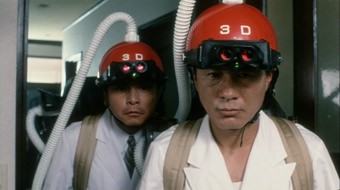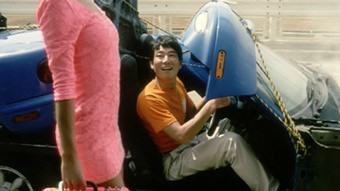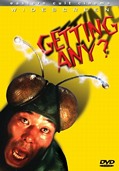Let's get one thing straight: Kitano Takeshi is a funny guy. He's also an immensely talented one. Originally a manzai comedian (a style of verbal comedy that features an extremely fast-talking double act), he has over the years enjoyed considerable success as a TV presenter, writer, columnist, painter, actor and film director. In the last of these roles he has particularly excelled, and through films such as Sonatine, Kids Return, Kikujiro, Dolls and Zatoichi has established himself as one of the premiere film-makers of the modern age. The legacy of his early comedy career is evident in the inspired comic moments that pepper his films, often created simply by cutting directly from the build-up to the aftermath of an incident that itself is not shown. At its best – such as in the near-drowning in Kikujiro or the burning of the teacher's car in Kids Return – the effect does not just provoke laughter, it develops the characters and advances the story. Given Kitano's skill as a director and a cinematic comedian, the prospect of a straight-up comedy film is a tantalising one, but Getting Any?, the director's first and to date only attempt at such a venture, has one major problem: it is, for the most part, dismayingly unfunny.
The plot, such as it is, has vacant nerd Asao suddenly deciding he needs to have sex and reasoning that to do so requires owning a car, a first class air ticket, or lots of money. This premise appears to be a thinly-veiled excuse to string a number of otherwise unrelated short sketches together – if Kitano has an idea for a scene involving a film set, then Asao reasons that movie stars get laid all the time so he'll become a movie star, and so on. Alternately silly, absurdist and slapstick, the film has less in common with the comedic elements of Kitano's other films than the moronic crudeness of the 'Dude, Where's My Brain?' style of American Idiot Comedy. Thus, Asao does stupid things in a stupid way and has all the sexual maturity of a 12-year-old who has just caught his first glimpse of a female breast, and approaches the idea of sexual relations in a similarly childish manner. Having reasoned that he needs a car to get laid, he tries to buy one but ends up with a vehicle that immediately falls apart in Laurel and Hardy fashion, then drives the clanking remains up to a female pedestrian and says "Let's have sex in the car." Oh how I laughed. We are never asked to engage with Asao, just to observe him making a repeatedly wince-inducing dick of himself as he dreams of encounters in which women repeatedly bare their chests and get willingly fondled, something that is never balanced by any kind of comment on the nature of material goods as an aphrodisiac for the intellectually shallow, which would at least have given these scenes a bit of an edge.

Given the director's inventively cinematic approach to humour elsewhere in his oeuvre, the fact that most of the scenes are so clumsily handled is particularly dispiriting, the visual gags created by Kitano's trademark before-and-after editing looking too often like desperate attempts to fake stunts through sleight of hand, and in a way that makes little real sense, even in comedic terms. Increasingly, the film plays like a tacky student review, with the emphasis on base humour and characters that are either spectacularly dumb or screamingly camp. The idea of a yakuza boss who expresses an excitable three-year-old's glee at a shadow puppet display is a potentially funny one, but is overplayed to the level of a music-hall drama queen – with a little more subtlety and some better bloody jokes, this could actually have worked.
This is not helped by a Mouse Hunt-like telegraphing of gags well before they happen, so when Asao is looking for a car, we cut to a man in a phone box complaining that his new car is no good because the brakes don't work. Can you guess what happens next? Correct. That said, you wouldn't be able to predict that the car would end up wedged halfway through an advertising hoarding, but since this twenty-foot leap from the road is executed by three unconvincingly strung together shots rather than any actual (or even comically exaggerated) inertia, the punch line comes across as daft for its own sake rather than a humorous conclusion to the sequence.
Just occasionally, we get a hint of the inventiveness that might have been. Mistaken for a top hit man, Asao attempts to repeat the gang's sharpshooter's trick of shooting a bullet though a tossed coin, but catches it on the way down and accidentally blows a hole in the head of another gang member. It's a move that at first outrages the gang's boss, but when it is revealed (in typically clumsy fashion, it has to be said) that the man was a double agent who was planning to assassinate him, he takes this as confirmation of Aasao's super-human killing instincts.
Perhaps the most interesting scene in retrospect has Asao working as an actor in what turns out to be an entry into the Zatoichi series, something that would have been instantly recognisable in Japan on the film's release and which prefigures Takeshi's own stylish remake of eight years later (this adds weight to the argument that Takeshi's involvement with the character stretches back some years and that he was far from just the director-for-hire that some of that film's nay-sayers have claimed). It is illustrative of the difference between the two films that while in Zatoichi an almost slapstick training scene is both smartly done and genuinely funny, Getting Any? passes up the opportunity to parody the filmmaking process in favour of having his actor blindly hurl manure over his fellow performers.

It's hard to be sure whether Kitano was shaping the humour for a specific audience or if he genuinely thought it was all very funny. I suspect it's a bit of both. I realise that I am talking from an English perspective here and have spent some long evenings in Japanese hotel rooms mesmerised by the exuberant tackiness of some of the TV, which includes a fair amount of comedy (some of which Takeshi himself appears in) that is every bit as ludicrously over-the-top and cheerfully do-it-yourself as the sketches that make up this film. Takeshi is an actor and director who was born of stage and television comedy, and this film is clearly an extension of that. But stood against his otherwise astonishing canon of work, with its sometimes stunning blend of violence, poetry, humanity and humour, Getting Any? feels like a jarring misfire, especially when you consider it was made immediately after his masterpiece, Sonatine, a film in which the comedy grows out of situation and character to sometimes magical effect. It is perhaps this cultural chasm that has delayed this film's arrival in the UK on any medium until now. For Takeshi fans it is still an essential curio, though it seems ironic that the audience that would most appreciate the film's base humour would never watch a movie with subtitles anyway.
| sound and vision |
As with Arts Magic's region 2 release of Higuchinsky's Uzumaki, it's a bit of a mixed bag. Framed at 16:9 and anamorphically enhanced, the black levels are solid throughout, and the contrast and colour are, though a little variable in places, generally very good. It's sharpness that lets the side down a bit, lacking the fine definition that makes you realise how much better DVD is than analogue tape and giving the transfer a somewhat low-rent look, though it does bear some of the hallmarks of an NTSC to PAL conversion. Not bad, but not great. Subtitles are removable and, on the whole, decently translated.
The Dolby 2.0 soundtrack is little more than functional, being very centre-weighted with almost no stereo separation. It is, however, clear and clean with a reasonable if unspectacular dynamic range.
| extra features |
Probably the key extra feature here is the Takeshi Kitano Interview, which is shot on 4:3 video, runs for 14 minutes and 40 seconds and was probably shot around the time of filming Zatoichi, (the white hair gives him away). It is conducted in Japanese with optional English subtitles and recorded for what was very likely a French DVD release – it is presented in its raw, unedited form and includes the behind-the-camera chatter of the interviewee and translator. This is a very good interview – Takeshi is on lively form and clearly has great affection for the film and counts it as one of his three finest works, making me wish I liked it more, and even suggests that it heavily influenced all of his later films. It becomes clear that the film struck a chord with audiences (though was not a big commercial success) but met with critical indifference at best, though it is the interviewer who brings up a quote from Takeshi's own past when he claimed of the film that "I wanted to make myself ludicrous to the point where viewers would say, 'This guy's had it'."
Alternate Sleeves looks at a 8 very similar designs for Arts Magic's DVD release of the film.
Bio/Filmographies has textual biographies/filmographies eight of the key performers, including Kitano. The amount of information provided varies, but some are very detailed – Kitano's is 19 screens long. The text is a very clear white on black that is easily read even on small monitors.
The Trailer is non-anamorphic 16:9 and runs for 2 minutes 48 seconds. It does give a flavour of the film's style and content, but is essentially an unadventurous collection of clips, very straightforwardly assembles.
The Stills Gallery is a collection of 20 pleasingly large behind-the-scenes stills, accompanied by the head of Fly Man.
Artwork is a collection of DVD covers for other Arts Magic releases. I was actually surprised how many there were.
| summary |
Comedy, more than any other genre, is a matter of taste, and my issues with Getting Any? are inevitably somewhat subjective. But Takeshi himself has repeatedly provided evidence of a more sophisticated and targeted approach to cinematic comedy in almost every other film he has made, films in which the humour arises organically from character and narrative, and even at its most surreal – the beach sumo match in Sonatine is a perfect example – feels somehow rooted in the essential truth of the story. Getting Any? mocks elements of Japanese popular culture, but for the most part this is frat house humour, all silly jokes, outlandish props and costumes, naked females, turd gags, daft music and pantomime acting, lacking only a loud fart to finish the mix off. But then every great director is allowed one misfire, and Takeshi is in good company here – it was the woeful attempt at comedy in the TV series On Air that surrealist maestro David Lynch fell flat on his behind. That UK Takeshi fans can finally catch up with this early work is to be celebrated, but I'm losing no sleep over the fact that he has not returned to this style of comedy film since.

